Coral reef
Coral reef
Often called “rainforests of the sea”, coral reefs form some of the most diverse ecosystems on earth. They occupy less than 1% of the world ocean surface, about half the area of France, yet they provide a home for 25% of all marine species, including fishes, molluscs, echinoderms and sponges.[1]
Paradoxically, coral reefs flourish even though they are surrounded by ocean waters that provide few nutrients. They are most commonly found at shallow depths in tropical waters, particularly in the Pacific Ocean, but deep water and cold water corals exist on a much smaller scale.
Coral reefs deliver ecosystem services to tourism, fisheries and shoreline protection. The annual global economic value of coral reefs has been estimated at $30 billion. However, coral reefs are fragile ecosystems, partly because they are very sensitive to water temperature. They are under threat from climate change, ocean acidification, blast fishing, cyanide fishing for aquarium fish, overuse of reef resources, and harmful land-use practices. High nutrient levels such as those found in runoff from agricultural areas can harm reefs by encouraging excess algae growth.[2]
Contents[hide] |
Formation
Most coral reefs were formed after the last glacial period when melting ice caused the sea level to rise and flood the continental shelves. This means that most coral reefs are less than 10,000 years old. As coral reef communities were established on the shelves, they built reefs that grew upwards, keeping pace with the rise in sea level. Reefs that didn't keep pace could become drowned reefs, covered by so much water that there was insufficient light for further survival.[3]Coral reefs are also found in the deep sea away from the continental shelves, around oceanic islands and as atolls. The vast majority of these ocean coral islands are volcanic in origin. The few exceptions have tectonic origins where plate movements have lifted the deep ocean floor on the surface.
In 1842 Charles Darwin published his first monograph, The Structure and Distribution of Coral Reefs.[4] There he set out his theory of the formation of atoll reefs, an idea he conceived during the voyage of the Beagle. His theory was that atolls were formed by the uplift and subsidence of the Earth's crust under the oceans.[5] Darwin’s theory sets out a sequence of three stages in atoll formation. It starts with a fringing reef forming around an extinct volcanic island as the island and ocean floor subsides. As the subsidence continues, the fringing reef becomes a barrier reef, and ultimately an atoll reef.
| Darwin’s theory starts with a volcanic island which becomes extinct | As the island and ocean floor subside, coral growth builds a fringing reef, often including a shallow lagoon between the land and the main reef | As the subsidence continues the fringing reef becomes a larger barrier reef further from the shore with a bigger and deeper lagoon inside | Ultimately the island sinks below the sea, and the barrier reef becomes an atoll enclosing an open lagoon |
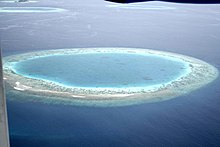
In general, the two main variables determining the geomorphology, or shape, of coral reefs are the nature of the underlying substrate on which they rest, and the history of the change in sea level relative to that substrate.
As an example of how coral reefs have formed on continental shelves, the current living reef structure of the Great Barrier Reef began growing about 20,000 years ago. The sea level was then 120 metres (390 ft) lower than it is today.[8][9] As the sea level rose, the water and the corals encroached on what had been the hills of the coastal plain. By 13,000 years ago the sea level was 60 metres (200 ft) lower than at present, and the hills of the coastal plains were, by then, continental islands. As the sea level rise continued most of the continental islands were submerged. The corals could then overgrow the hills, forming the present cays and reefs. The sea level on the Great Barrier Reef has not changed significantly in the last 6,000 years,[9] and the age of the present living reef structure is estimated to be between 6,000 and 8,000 years.[10] Although the Great Barrier Reef formed along a continental shelf, and not around a volcanic island, the same principles apply as outlined by Darwin's theory above. The Great Barrier Reef development has stopped at the barrier reef stage, since Australia is not about to submerge. It has formed the world's largest barrier reef, 300–1000 metres (330-1100 yards) from shore, and 2,000 kilometres (1,200 mi) long.[11]
Healthy coral reefs grow horizontally from 1 to 3 centimetres (0.39 to 1.2 in) per year, and grow vertically anywhere from 1 to 25 centimetres (0.4–12 in) per year; however, they are limited to growing above a depth of 150 metres (490 ft) due to their need for sunlight, and cannot grow above sea level.[12]
Types
The three principal reef types are:- Fringing reef – a reef that is directly attached to a shore or borders it with an intervening shallow channel or lagoon.
- Barrier reef – a reef separated from a mainland or island shore by a deep lagoon.
- Atoll reef – a more or less circular or continuous barrier reef extending all the way around a lagoon without a central island.
- Patch reef – an isolated, comparatively small reef outcrop, usually within a lagoon or embayment, often circular and surrounded by sand or seagrass. Patch reefs are common.
- Apron reef – a short reef resembling a fringing reef, but more sloped; extending out and downward from a point or peninsular shore.
- Bank reef – a linear or semi-circular shaped-outline, larger than a patch reef.
- Ribbon reef – a long, narrow, somewhat winding reef, usually associated with an atoll lagoon.
- Table reef – an isolated reef, approaching an atoll type, but without a lagoon.
- Microatolls – certain species of corals form communities called microatolls. The vertical growth of microatolls is limited by average tidal height. By analysing the various growth morphologies, microatolls can be used as a low resolution record of patterns of sea level change. Fossilized microatolls can also be dated using radioactive carbon dating. Such methods have been used to reconstruct Holocene sea levels.[13]

- Cays – small, low-elevation, sandy islands formed on the surface of a coral reef. Material eroded from the reef piles up on parts of the reef or lagoon, forming an area above sea level. Plants can stabilize cays enough for them to be habitable by humans. Cays occur in tropical environments throughout the Pacific, Atlantic and Indian Oceans (including in the Caribbean and on the Great Barrier Reef and Belize Barrier Reef), where they provide habitable and agricultural land for hundreds of thousands of people. Their surrounding reef ecosystems also provide food and building materials for island inhabitants.
- When a coral reef cannot keep up with the sinking of a volcanic island, a seamount or guyot is formed. Seamounts and guyots are below the surface of the ocean and may host many species, depending on their location and depth. Seamounts are rounded at the top and guyots are flat. The flat top of the guyot, also called a tablemount, is due to erosion by waves, winds, and atmospheric processes.
Distribution
Although corals exist both in temperate and tropical waters, shallow-water reefs form only in a zone extending from 30° N to 30° S of the equator. Tropical corals do not grow at depths of over 50 meters (160 ft). The optimum temperature for most coral reefs is 26–27 °C, and few reefs exist in waters below 18 °C.[15] However reefs in the Persian Gulf have adapted to temperatures of 13 °C in winter and 38 °C in summer.[16]
Deep water coral is more still exceptional since it can exist at greater depths and colder temperatures. Although deep water corals can form reefs, very little is known about them.
Coral reefs are rare along the American west coast, as well as along the African west coast. This is due primarily to upwelling and strong cold coastal currents that reduce water temperatures in these areas (respectively the Peru, Benguela and Canary streams).[17] Corals are seldom found along the coastline of South Asia from the eastern tip of India (Madras) to the border of Bangladesh and Myanmar.[14] They are also rare along the coast around north-eastern South America and Bangladesh due to the freshwater release from the Amazon and Ganges Rivers respectively.
- Principal coral reefs and reef areas of the world
- The Great Barrier Reef - largest coral reef system in the world, Queensland, Australia.
- The Belize Barrier Reef - second largest in the world, stretching from southern Quintana Roo, Mexico along the coast of Belize to the Bay Islands of Honduras.
- The New Caledonia Barrier Reef - second longest double barrier reef in the world, with a length of about 1,500 kilometers (930 mi).
- The Andros, Bahamas Barrier Reef - third largest in the world, following the east coast of Andros Island, Bahamas, between Andros and Nassau.
- The Red Sea Coral Reef - located off the coast of Israel, Egypt, Sudan, Eritrea, Djibouti, Somalia, Jordan, Saudi Arabia, and Yemen.
- Pulley Ridge - deepest photosynthetic coral reef, Florida.
- Numerous reefs scattered over the Maldives.
- Ghe Raja Ampat Islands in Indonesia's West Papua province offer the highest known marine diversity.[18]
Biology
Reef-building or hermatypic corals are only found in the photic zone (above 50 m depth), the depth to which sufficient sunlight penetrates the water for photosynthesis to occur. Coral polyps do not photosynthesize, but have a symbiotic relationship with single-celled organisms called zooxanthellae; these cells within the tissues of the coral polyps carry out photosynthesis and produce excess organic nutrients that are then used by the coral polyps. Because of this relationship, coral reefs grow much faster in clear water, which admits more sunlight. Indeed, the relationship is responsible for coral reefs in the sense that without their symbionts, coral growth would be too slow for the corals to form impressive reef structures. Corals get up to 90% of their nutrients from their zooxanthellae symbionts.[23]

Internally fertilized eggs develop in the polyp for a period ranging from days to weeks. Subsequent development produces a tiny larva, known as a planula. Externally fertilized eggs develop during synchronized spawning. Polyps release eggs and sperm into the water simultaneously. Eggs disperse over a large area. Spawning depends on four factors: time of year, water temperature, and tidal and lunar cycles. Spawning is most successful when there is little variation between high and low tides. The less water movement, the better the chance for fertilization. Ideal timing occurs in the spring. Release of eggs or planula larvae usually occurs at night and is sometimes in phase with the lunar cycle (3–6 days after a full moon). The period from release to settlement lasts only a few days, but some planulae can survive afloat for several weeks (7, 14). They are vulnerable to heavy predation and adverse environmental conditions. For the lucky few who survive to attach to substrate, the challenge comes from competition for food and space.
There are about one thousand species of coral, which build different shapes such as wrinkled brains, cabbages, table tops, stag antlers, wire strands and pillars.
Darwin's paradox
Recent oceanographic research has brought to light the reality of this paradox by confirming that the oligotrophy of the ocean euphotic zone persists right up to the swell-battered reef crest. When you approach the reef edges and atolls from the quasi-desert of the open sea, the near absence of living matter suddenly becomes a plethora of life, without transition. So why is there something rather than nothing, and more precisely, where do the necessary nutrients for the functioning of this extraordinary coral reef machine come from ? — Francis Rougerie[24]
Coral reefs cover just under one percent of the surface of the world’s ocean, yet they support over one-quarter of all marine species. This huge number of species results in complex food webs, with large predator fish eating smaller forage fish that eat yet smaller zooplankton and so on. However, all food webs eventually depend on plants, which are the primary producers. The primary productivity on a coral reef is very high, resulting in a typical biomass production of 5-10g C m−2 day−1.[25]
Tropical waters are often described as crystal clear. This is because they are deficient in nutrients and drifting plankton. The sun shines year round in the tropics, warming the surface ocean layer so it is less dense than subsurface layers. The warmer water is separated from the cooler water by a stable thermocline, where the temperature makes a rapid change. This keeps the warm surface waters floating above the cooler deeper waters. There is little exchange between these layers. Organisms that die in aquatic environments generally sink to the bottom where they decompose. This decomposition releases nutrients in the form of nitrogen, phosphorus and potassium. These nutrients, N, P and K, are necessary for plant growth, but in the tropics they are not directly recycled back to the surface.[7]
Plants are the base of the food chain, and need sunlight and nutrients if they are to grow. In the ocean these plants are mainly a type of plankton, microscopic phytoplankton which drift in the water column. They need sunlight for photosynthesis, which powers carbon fixation, so they are found only in the surface waters. But they also need nutrients. Phytoplankton rapidly use any nutrients in the surface waters, and in the tropics these nutrients are not usually replaced because of the thermocline.[7]
The situation with coral reefs is different. The lagoons that are formed by the upward growth of coral reefs fill in with material eroded from the reef and the island. They become havens for marine life, providing protection from waves and storms.
Most importantly, nutrients are recycled, and not lost like they are in the open ocean. In coral reefs and lagoons, the producers include phytoplankton as well as marine worms, seaweed, and coralline algae, especially small types called turf algae, which pass their nutrients to the corals.[26] The phytoplankton are eaten by fish and crustaceans, who also pass nutrients along the food web. Recycling ensures that fewer nutrients are needed overall to support the community.
Corals harbour numerous symbiotic organisms. In particular, there is a remarkable symbiosis between coral and a microscopic algae, the single cell dinoflagellate known as a zooxanthella. The zooxanthella forms an endosymbiosis with a coral polyp, that is, it lives within the tissues of the polyp. There it absorbs solar energy with special pigments, using photosynthesis to supply the polyp with organic nutrients in the form of glucose, glycerol, and amino acids.[27] Zooxanthellae can provide up to 90% of a coral’s energy requirements.[28] In return, as an example of mutualism, the coral provides the zooxanthellae, averaging one million for every cubic centimetre of coral, with a relatively safe place to live and a constant supply of the carbon dioxide it needs for photosynthesis.
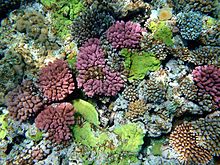
A 2001 paper reported that sponges are another key to explaining Darwin’s paradox. These sponges live in crevices in the coral reefs. They are efficient filter feeders, and in the Red Sea they consume about sixty percent of the phytoplankton that drifts by. The nutrients the sponges absorb from the phytoplankton are then excreted in a form the corals can use.[29]
Researchers in 2002 explained why coral thrives better in agitated waters. They found the roughness of coral surfaces is the key. Normally there is a boundary layer of still water around a submerged object which acts as a barrier. But when waves break on the extremely rough edges of corals the boundary layer is disrupted, allowing the corals access to the few nutrients that are there. The researchers claim that turbulent water promotes rapid reef growth and lots of branching. Although coral ecosystems are great at recycling, with the wastes of one species becoming the food of another, the researchers also claim that, without the nutritional gains achieved by rough coral surfaces, even the most effective recycling would leave corals wanting in nutrients.[30]
In 2004, another symbiotic organism, a bacteria called Cyanobacteria, was discovered to provide soluble nitrates for the reef via nitrogen fixation.[31]
Coral reefs also often depend on other habitats, such as seagrass meadows and mangrove forests in the surrounding area for the supply of nutrients. Seagrass and mangroves supply dead plants and animals which are rich in nitrogen and also serve to feed fish and animals from the reef by supplying wood and vegetation. Reefs in turn protect mangroves and seagrass from waves and produce sediment for the mangroves and seagrass to root in.[32]
Zones
Coral reef ecosystems contain a number of distinctive zones that represent different kinds of habitats for fishes and invertebrate animals. Usually, three major zones are recognized: the fore reef (outermost and deepest part of the reef), reef crest (shallowest and narrowest zone over which ocean waves break), and the back reef (behind the reef crest and closest to shore, with calm protected waters) which is also frequently referred to as the reef lagoon.All three zones are physically and ecologically interconnected to some extent, with reef life and oceanic processes creating ample opportunities for exchange of ocean water, sediments, nutrients, and marine life between one another.
Thus, they should properly be viewed as integrated components of the coral reef ecosystem, each playing a role in the support of the abundant and diverse fish assemblages that characterize coral reefs.
Most coral reefs exist in shallow waters less than fifty metres deep. Some are found on tropical continental shelves where cool, nutrient rich upwelling does not occur, such as Great Barrier Reef. Others are found in the deep ocean surrounding islands or as atolls, such as in the Maldives. The reefs surrounding islands form when islands subside into the ocean, and atolls form when an island subsides below the surface of the sea.
Moyle and Cech[33] distinguish six major zones, though most reefs possess only some of the zones.
- The reef surface is the shallowest part of the reef. It is subject to the constant surge of waves and the rise and fall of tides. When water waves pass over shallow areas, they shoal, as shown in the diagram at the right. This means that the water in the reef surface zone is often agitated. These are the precise condition under which coral flourish. Shallowness means there is plenty of light for photosynthesis, and agitated water promotes the ability of coral to feed on plankton. However other organisms, such as fish and invertebrates, must be able to withstand the robust conditions to flourish in this zone.
- The off-reef floor is the shallow sea floor surrounding a reef. This zone applies to reefs on continental shelves. Reefs around tropical islands and atolls drop abruptly to great depths, and don't have an off-reef floor. Usually sandy, the off-reef floor often supports seagrass meadows which are important foraging areas for reef fish.
- The reef drop-off is, for its first 50 metres, habitat for many reef fish who find shelter on the cliff face and plankton in the water nearby. The drop-off zone applies mainly to the reefs surrounding oceanic islands and atolls.
- The reef face is the zone above the reef floor or the reef drop-off. "It is usually the richest habitat for fish and invertebrates. Its complex growths of coral and calcareous algae provide innumerable cracks and crevices for protection, and the abundant invertebrates and epiphytic algae provide an ample source of food."[33]
- The reef flat – sandy bottomed flat can be behind the main reef, containing chunks of coral. "The reef flat may be a protective area bordering a lagoon, or it may be a flat, rocky area between the reef and the shore. In the former case, the number of fish species living in the area often is the highest of any reef zone."[33]
- The reef lagoon – "many coral reefs completely enclose an area, thereby creating a quiet-water lagoon that usually contains small patched of reef."[33]
Biodiversity
Researchers have found evidence of algae dominance in locations of healthy coral reefs. In surveys done around largely uninhabited US Pacific islands, algae inhabit a large percentage of surveyed coral locations.[34] The algae population consists of turf algae, coralline algae, and macroalgae.
Fish
- fish that adjust the coral (such as Labridae and parrotfish) These types of fish feed either on small animals living near the coral, seaweed, or on the coral itself. Fish that feed on small animals include cleaner fish (these fish feed between the jaws of larger predatory fish), bullet fish and Balistidae (these eat sea urchins) while seaweed eating fish include the Pomacentridae (damselfishes). Serranidae cultivate the seaweed by removing creatures feeding on it (as sea urchins), and they remove inedible seaweeds. Fish that eat coral include parrotfish and butterflyfish.
- fish that cruise the boundaries of the reef or nearby seagrass meadows. These include predatory fish such as pompanos, groupers, Horse mackerels, certain types of shark, Epinephelus marginatus, barracudas, snappers, ...) They also include herbivorous and plankton-eating fish. Fish eating seagrass include Horse mackerel, snapper, Pagellus, Conodon, ... Fish eating plankton include Caesio, manta ray, chromis, Holocentridae, pterapogon kauderni, ...
Other fish groups found on coral reefs include groupers, grunts and wrasses. Over 4,000 species of fish inhabit coral reefs.[14] It has been suggested that the fish species that inhabit coral reefs are able to coexist in such high numbers because any free living space is inhabited by the first planktonic fish larvae that find it in what has been termed "a lottery for living space".[35]
Seabirds
Coral reef systems provide important habitats for seabird species, some endangered. For example, Midway Atoll supports nearly three million seabirds, including two-thirds (1.5 million) of the global population of Laysan Albatross, and one-third of the global population of black-footed albatross.[36] Each seabird species have specific sites on the atoll where they nest. Altogether, 17 species of seabirds live on Midway. The short-tailed albatross is the rarest, with fewer than 2,200 surviving after excessive feather hunting in the late nineteenth century.[37]Invertebrates
Invertebrates have their part in the food-chain of the reef. For example, sea urchins, Dotidae and sea slugs eat seaweed. Some species of sea urchins, such as Diadema antillarum, can play a pivotal part in preventing algae overrunning reefs.[38] Hawksbill turtles, Nudibranchia and sea anemones eat sponges.A number of invertebrates, collectively called cryptofauna, inhabit the coral skeletal substrate itself, either boring into the skeletons (through the process of bioerosion) or living in pre-existing voids and crevices. Those animals boring into the rock include sponges, bivalve molluscs, and sipunculans. Those settling on the reef include many other species, particularly crustaceans and polychaete worms.[17]
Other
Sea snakes feed exclusively on fish and their eggs. Many tropical birds forage on reef fish, such as herons, gannets, pelicans and boobies. Some land based reptiles can be intermittently associated with reefs, such as monitor lizards, the marine crocodile and semi-aquatic snakes like Laticauda colubrina.| Shoaling reef fish |
Economic value
Coral reefs deliver ecosystem services to tourism, fisheries and coastline protection. The global economic value of coral reefs has been estimated at $30 billion.[39] Coral reefs protect shorelines by absorbing wave energy, and many small islands would not exist without their reef to protect them. According to the WWF, the economic cost over a 25 year period of destroying one kilometre of coral reef is somewhere between $137,000 and $1,200,000.[40] About 6 million tons of fish are taken each year from coral reefs. Well managed coral reefs have an annual yield of 15 tons seafood on average per square kilometre. Southeast Asia's coral reef fisheries alone yield about $ 2.4 billion annually from seafood.[40]Issues
Southeast Asian coral reefs are at risk from damaging fishing practices (such as cyanide and blast fishing), overfishing, sedimentation, pollution and bleaching. A variety of activities, including education, regulation, and the establishment of marine protected areas are under way to protect these reefs.
Indonesia, is home to a third of the world's total corals and a quarter of its fish species, nearly 33,000 square miles (85,000 km2). Indonesia's coral reefs are located in the heart of the Coral Triangle and have fallen victim to destructive fishing, unregulated tourism, and bleaching due to climatic changes. Data from 414 reef monitoring stations in 2000 found that only 6% are in excellent condition, while 24% are in good condition, and approximately 70% are in poor to fair condition (2003 The Johns Hopkins University).
In 2007, Reef Check, the world’s largest reef conservation organization, stated that only 5% of Philippines 27,000 square-kilometers of coral reef are in "excellent condition": Tubbataha Reef, Marine Park in Palawan, Apo Island in Negros Oriental, Apo Reef in Puerto Galera, Mindoro, and Verde Island Passage off Batangas. Philippine coral reefs is second largest in Asia.[43]
General estimates show approximately 10% world's coral reefs are already dead.[44][45][46] It is estimated that about 60% of the world's reefs are at risk due to destructive, human-related activities. The threat to the health of reefs is particularly strong in Southeast Asia, where 80% of reefs are endangered.
Fishing practices
Overfishing, particularly selective overfishing, can unbalance coral ecosystems by encouraging the excessive growth of coral predators. Predators which eat living coral, such as the crown-of-thorns starfish, are called corallivores. Coral reefs are built from stony coral, which evolved with large amounts of the wax cetyl palmitate in their tissues. Most predators find this wax indigestible.[47] The crown-of-thorns starfish is a large (up to one metre) starfish protected with long, venomous spikes. It has an enzyme system which dissolves the wax in stony corals, and allows the starfish to feed on the living coral. Normally the starfish are kept under control by the giant triton sea snail. However, the giant triton is valued for its shell, and has been severely overfished. As a result, crown-of-thorns starfish populations can periodically explode without check, devastating coral reefs.[48][49][50]
| | The crown of thorns starfish eats coral |
Dynamite fishing is another destructive method for gathering fish. Sticks of dynamite, grenades, or home-made explosives are simply thrown in the water. This method of fishing kills the fish within the main blast area, along with many inedible and/or unwanted reef animals. The blast also kills the corals in the area, eliminating the very structure of the reef, destroying the habitat for fish and other animals important for the maintenance of a healthy reef.[53] Other destructive fishing methods, such as muroami and kayakas, kill all fish in certain areas, causing havoc on the ecosystem of the reef.[53]
Hughes, et al., (2003), wrote that "with increased human population and improved storage and transport systems, the scale of human impacts on reefs has grown exponentially. For example, markets for fish and other natural resources have become global, supplying demand for reef resources."[54]
Pollution
Reefs in close proximity to human populations can be faced with local stresses, including poor water quality from land-based sources of pollution.[55] Copper, a common industrial pollutant has been shown to interfere with the life history and development of coral polyps.[57] Poor water quality has also been shown to encourage the spread of infectious diseases among corals.[58]
In addition to soil runoff, additional soil and sand is blown in from other regions. Dust from the Sahara moving around the southern periphery of the subtropical ridge moves into the Caribbean and Florida during the warm season as the ridge builds and moves northward through the subtropical Atlantic. Dust can also be attributed to a global transport from the Gobi and Taklamakan deserts across Korea, Japan, and the Northern Pacific to the Hawaiian Islands.[59] Since 1970, dust outbreaks have worsened due to periods of drought in Africa. There is a large variability in dust transport to the Caribbean and Florida from year to year;[60] however, the flux is greater during positive phases of the North Atlantic Oscillation.[61] The USGS links dust events to a decline in the health of coral reefs across the Caribbean and Florida, primarily since the 1970s.[62] Studies have shown that corals can incorporate dust into their skeletons as identified from dust from the 1883 eruption of Krakatoa in Indonesia in the annular bands of the reef-building coral Montastraea annularis from the Florida reef tract.[63]
Climate change
Warming may also be the basis of a new emerging problem: increasing coral diseases. Warming, thought to be the main cause of coral bleaching, weakens corals. In their weakened state, coral is much more prone to diseases including black band disease, white band disease and skeletal eroding band. If global temperatures increase by 2 °C, coral may not be able to adapt quickly enough physiologically or genetically.[65] It has been estimated that, in order to counter the threat of ocean acidification through global warming, a reduction of up to 40% of current emissions is needed, and up to 95% by 2050. This requires emission reductions larger than the reductions currently proposed for these dates by the EU.[66]
Ocean acidification

Ocean surface pH is estimated to have decreased from about 8.25 to 8.14 since the beginning of the industrial era,[68] and it is estimated that it will drop by a further 0.3–0.4 units by 2100 as the ocean absorbs more anthropogenic carbon dioxide.[69] Normally, the conditions for calcium carbonate production are stable in surface waters since the carbonate ion is at supersaturating concentrations. However, as ocean pH falls, so does the concentration of this ion, and when carbonate becomes under-saturated, structures made of calcium carbonate are vulnerable to dissolution. Research has already found that corals experience reduced calcification or enhanced dissolution when exposed to elevated CO2.[70]
Bamboo coral is a deep sea coral which produces growth rings similar to a tree. The growth rings picture how growth rates change as deep sea condition change over time, and can also record changes due to ocean acidification. This coral is especially long-lived. Coral specimens as old as 4,000 years old have given scientists "4,000 years worth of information about what has been going on in the deep ocean interior".[71]
Other issues
Coral mining is another threat. Both small scale harvesting by villagers and industrial scale mining by companies are serious threats. Mining is usually done to produce construction material which is valued as much as 50% cheaper than other rocks, such as from quarries.[16] The rocks are ground and mixed with other materials, like cement to make concrete. Ancient coral used for construction is known as coral rag. Building directly on the reef also takes its toll, altering water circulation and the tides which bring the nutrients to the reef. The pressing reason for building on reefs is simply lack of space.
Threatened species
The global standard for recording threatened marine species is the IUCN Red List of Threatened Species.[75] This list is the foundation for marine conservation priorities worldwide. A species is listed in the threatened category if it is considered to be critically endangered, endangered, or vulnerable. Other categories are near threatened and data deficient. By 2008, the IUCN had assessed all known reef-building corals species as follows[76]| Group | Species | Threatened | Near threatened | Data deficient |
|---|---|---|---|---|
| Reef-building corals | 845 | 27% | 20% | 17% |
Protection
Biosphere reserves are other protected areas that may protect reefs. Also, Marine parks, as well as world heritage sites can protect reefs. World heritage designation can also play a vital role. For example the Chagos archipelago, Sian Ka'an, the Great Barrier Reef, Henderson Island, the Galapagos islands, Belize's Barrier reef and Palau have been designated as protected by nomination as a world heritage site.
In Australia, the Great Barrier Reef is protected by the Great Barrier Reef Marine Park Authority, and is the subject of much legislation, including a Biodiversity Action Plan.
Inhabitants of Ahus Island, Manus Province, Papua New Guinea, have followed a generations-old practice of restricting fishing in six areas of their reef lagoon. Their cultural traditions allow line fishing but not net and spear fishing. The result is that both the biomass and individual fish sizes are significantly larger in these areas than in places where fishing is unrestricted.[77][78]
Restoration
During mineral accretion, the settled corals display an increased growth rate, and size, and density, but after the process is complete, growth rate and density return to levels that are comparable to naturally growing corallites, and are about the same size or slightly smaller.[79]
In large restoration projects, depending on the type of coral, placement of propagated hermatypic coral unto substrate is often done with metal pins, superglue or milliput.[80] Needle and thread can also attach A-hermatype coral to substrate.[81] Concrete has also been used to restore large sections of broken coral reef. Finally, special structures as reef balls can be placed to provide corals a base to grow on.
Labels: Nice Info
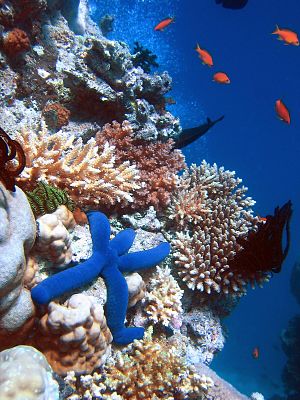


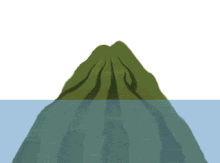
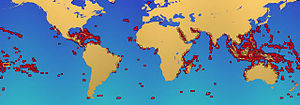
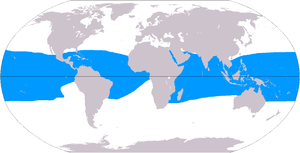
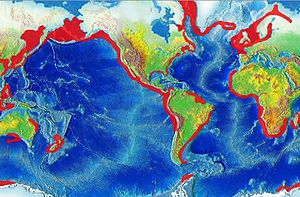


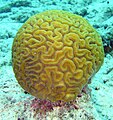




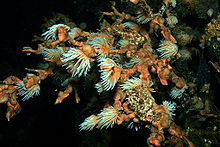


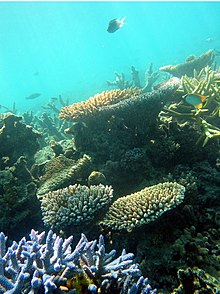

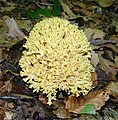





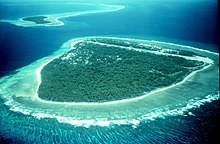


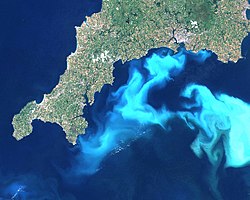







0 Comments:
Post a Comment
Subscribe to Post Comments [Atom]
<< Home